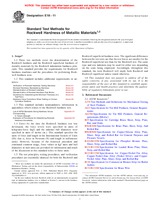We need your consent to use the individual data so that you can see information about your interests, among other things. Click "OK" to give your consent.
ASTM E18-11
Standard Test Methods for Rockwell Hardness of Metallic Materials
STANDARD published on 1.11.2011
The information about the standard:
Designation standards: ASTM E18-11
Note: WITHDRAWN
Publication date standards: 1.11.2011
SKU: NS-43089
The number of pages: 37
Approximate weight : 111 g (0.24 lbs)
Country: American technical standard
Category: Technical standards ASTM
Annotation of standard text ASTM E18-11 :
Keywords:
hardness, mechanical test, metals, Rockwell, Metal electrical conductors, Calibration--metals/alloys analysis instrumentation, Rockwell hardness, Testing machines, Verification, ICS Number Code 77.040.10 (Mechanical testing of metals)
Additional information
| Significance and Use | ||||||||||||||||||||||||||||||||||||||||||||||
|
The Rockwell hardness test is an empirical indentation hardness test that can provide useful information about metallic materials. This information may correlate to tensile strength, wear resistance, ductility, and other physical characteristics of metallic materials, and may be useful in quality control and selection of materials. Rockwell hardness tests are considered satisfactory for acceptance testing of commercial shipments, and have been used extensively in industry for this purpose. Rockwell hardness testing at a specific location on a part may not represent the physical characteristics of the whole part or end product. Adherence to this standard test method provides traceability to national Rockwell hardness standards except as stated otherwise. |
||||||||||||||||||||||||||||||||||||||||||||||
| 1. Scope | ||||||||||||||||||||||||||||||||||||||||||||||
|
1.1 These test methods cover the determination of the Rockwell hardness and the Rockwell superficial hardness of metallic materials by the Rockwell indentation hardness principle. This standard provides the requirements for Rockwell hardness machines and the procedures for performing Rockwell hardness tests. 1.2 This standard includes additional requirements in annexes:
1.3 This standard includes nonmandatory information in appendixes which relates to the Rockwell hardness test.
1.4 Units—At the time the Rockwell hardness test was developed, the force levels were specified in units of kilograms-force (kgf) and the indenter ball diameters were specified in units of inches (in.). This standard specifies the units of force and length in the International System of Units (SI); that is, force in Newtons (N) and length in millimeters (mm). However, because of the historical precedent and continued common usage, force values in kgf units and ball diameters in inch units are provided for information and much of the discussion in this standard refers to these units. 1.5 The test principles, testing procedures, and verification procedures are essentially identical for both the Rockwell and Rockwell superficial hardness tests. The significant differences between the two tests are that the test forces are smaller for the Rockwell superficial test than for the Rockwell test. The same type and size indenters may be used for either test, depending on the scale being employed. Accordingly, throughout this standard, the term Rockwell will imply both Rockwell and Rockwell superficial unless stated otherwise. 1.6 This standard does not purport to address all of the safety concerns, if any, associated with its use. It is the responsibility of the user of this standard to establish appropriate safety and health practices and determine the applicability of regulatory limitations prior to use. |
||||||||||||||||||||||||||||||||||||||||||||||
| 2. Referenced Documents | ||||||||||||||||||||||||||||||||||||||||||||||
|
We recommend:
Technical standards updating
Do you want to make sure you use only the valid technical standards?
We can offer you a solution which will provide you a monthly overview concerning the updating of standards which you use.
Would you like to know more? Look at this page.




 Cookies
Cookies
